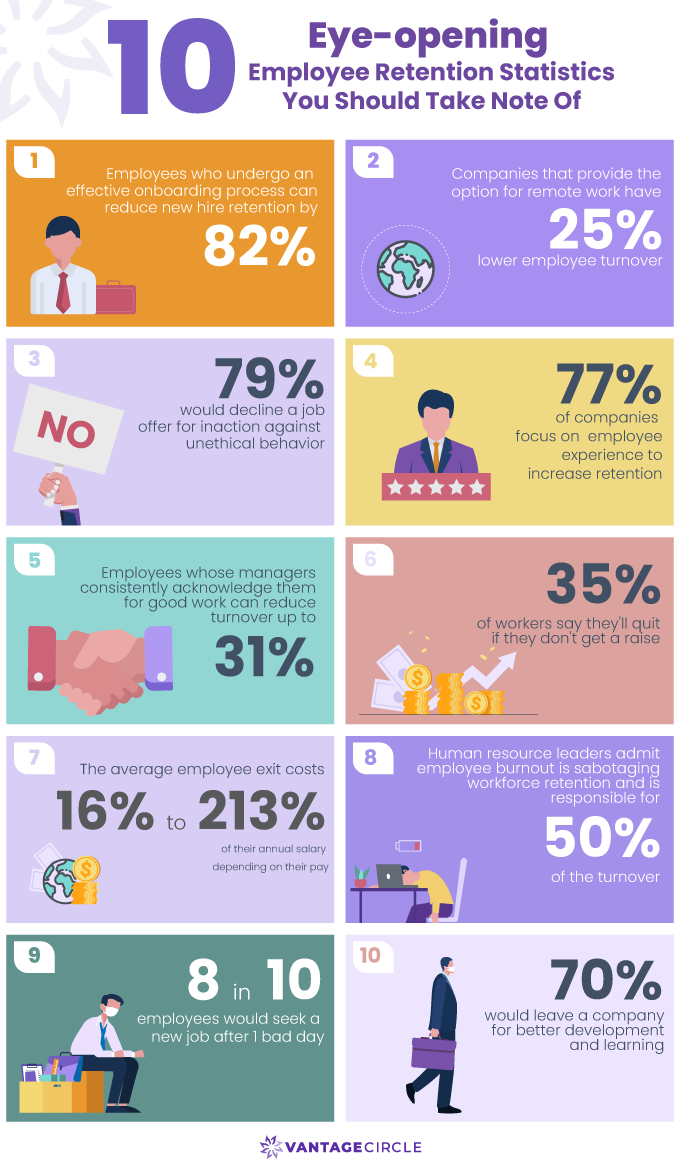10 Eye-opening Employee Retention Statistics You Should Take Note Of

New companies and new opportunities are coming up every day. With so much to choose from, employees don't think twice before switching their job if their current one doesn't suit them.
To keep up with the changing times and needs, employers need to be mindful of managing their employees.
What better than looking at some solid numbers before you plan your employee retention strategy!

1) Employees who undergo an effective onboarding process can reduce new hire retention by 82%. (Source)
The onboarding program is the first official interaction a new hire has with the company. So setting a good first impression can go a long way in building employee-management relationships.
An effective onboarding program is a lot more than just hiring. It is letting your employees know about the company benefits, history, and culture. Modern orientation and onboarding processes focus on outlining the goals and objectives, expectations, and skills an employee must own. Setting the objectives early enables employees to clarify what is expected and how they can achieve the set goals.
2) Companies that provide the option for remote work have 25% lower employee turnover. (Source)
When the pandemic hit the world, remote jobs have increased more than ever. Most of the people looking for a new job consider work flexibility as a make or breakpoint.
A survey shows that 1 out of 3 workers will seek a new job if asked to return to offices for full-time. Hybrid workplaces and staggered work shifts are also one of the most popular employee retention ideas.
3) 79% of employees wouldn’t accept a job at a company with a higher salary unless the company failed to take actions against employees involved in unethical behaviour. (Source)
We saw a rise in cases of sexual harassment faced by women in their workplaces. From corporates to the entertainment industry. It gave rise to the #Metoo movement, where women started sharing their stories.
The above survey by Manifest shows that employees are becoming more mindful of their colleagues and their working environments. Companies, too, must strive towards making workplaces safe and practice their work ethics. They must be unbiased towards their treatment of employees (that goes for both the accused and the victim).
4) 77% of companies focus on employee experience to increase retention. (Source)
Employee engagement is different from employee experience. Employee engagement is an approach to drive results and keep employees motivated. Employee experience is what you do for them and how you make them feel. 96% of employees say that employee experience is an essential part of their work-life.
Engaged employees are the section of your workforce who are emotionally attached to their work. They are invested in their responsibilities and satisfied with their work experience.
(Related- 25 Employee Engagement Activities To Reinvent Your Workforce)
5) Employees whose managers consistently acknowledge them for good work can reduce turnover up to 31%. (Source)
Employee recognition is fundamental to an organisation’s retention efforts.
Imagine you've been working on a project for the last month. You finish it successfully, and the client loves it. But your boss does not acknowledge your efforts or recognize your excellent work. How does that make you feel?
Disappointed and sad, right? Now shift this to you being this kind of boss and the praise you didn't give to a deserving employee. Do you still think your employee will want to work under such a manager? I wouldn't.
Recognizing and appreciating someone doesn't mean you're picking favorites or being biased. It's showing your employees that you take notice of their efforts. Their hard work contributes to the company's bottom line. Such employees will always stay motivated to work hard and achieve goals. They will remember the feeling of satisfaction they felt when you appreciated them.
(Related- 33 Rewards and Recognition Ideas to Boost Employee Recognition in 2022)
6) 35% of workers say they'll quit if they don't get a raise.(Source)
A survey conducted on 900 employees showed that 35% would quit their jobs if they don't get a raise. Employees under the age of 35 are most likely to walk away for better job opportunities. They feel they are underpaid.
Some are not satisfied with the company's benefits policy. A lot of them said another cause of dissatisfaction was the limited career growth.
Have one-on-one meetings, conduct surveys, and have a competitive compensation and benefit system.
7) The average employee exit costs 16% to 213% of their annual salary depending on their pay. (Source)
Hiring an employee takes time, resources, and money. When an employee leaves, it costs the employer 16% to 213% of that employee's salary to get them replaced.
The same report also highlights the indirect costs of employee turnover. These indirect costs are in the form of productivity loss. When an employee leaves, she takes with herself her knowledge, skills, and experience. It causes a gap between the work that needs to be done and the lack of available skills to do that work. Even after you hire a new replacement, it takes time and training for them to contribute fully.
The only way to stop this from happening is by conducting regular 1:1 meetings with your employees to understand their needs and concerns.
8) Human resource leaders admit employee burnout is sabotaging workforce retention. It handles 50% turnover. (Source)
We say that employees are an organization's biggest asset. They drive your business towards loyal customers and generate revenue for your business. Thus, as HR leaders, their well-being should be your top priority.
Too much overtime and overwork are sapping the life out of your employees. Moreover, with the new generation being so adamant about work-life balance, organizations must bring the latest changes.
Mollie Lombardi, CEO of Aptitude Research, has said, "Not all burnout can be eliminated. Much of it can be avoided using strategies that balance consistency and personalization of schedules and workload. Leverage managers as models for how their team can achieve work/life balance. Help them implement tools and technology that proactively manage burnout or otherwise support these efforts."
9) 8 in 10 employees would seek a new job after 1 bad day. (Source)
Employee retention factor is becoming challenging and very competitive. The same survey also found that 81% of job seekers cited dissatisfaction as the primary reason they started to look elsewhere for work.
More than half of the respondents say they feel underpaid. Some are not satisfied with the company’s benefits policy. A lot of them told another cause of dissatisfaction was limited career growth.
Some other reasons for dissatisfaction which managers need to look out for are hostile work culture, unsupportive boss, lack of meaningful work, work and life balance.
It is prominent for millennial and Gen Z employees. If they don't get job satisfaction from their work, there's no way they're going to be associated with that company.
10) 70% of staff members would leave their current organizations for a job with one known for investing in employee development and learning. (Source)
In the survey, career development was ranked the 2nd most important need after compensation that made employees want to stay.
Employee development is crucial to managing an organization's turnover rate. To excel and become experts in a field, employees need to gain knowledge and experience. That is only possible when they advance in their career, work with new teams and learn new skills.
On the other hand, if employees feel their growth and exposure have become stagnant in a company, they'll start looking for other opportunities.
In Conclusion
These statistics point towards the transition that workplaces are going through and what future businesses need to do to retain their top talent.

















